
Original Link: https://www.anandtech.com/show/1343
Q2 2004 Desktop Hard Drive Comparison: WD Raptor vs the World
by Anand Lal Shimpi on June 7, 2004 12:05 AM EST- Posted in
- Storage
The biggest argument to why you would ever need a faster CPU is often that everything is disk limited anyways, so getting a faster CPU isn't the solution to your performance woes. While, to an extent, this is true, we have seen over the years that quite a few things are just as CPU bound as they are disk bound.
We've shown in the past that even very disk intensive operations, such as extracting a zip archive, can vary significantly with CPU. We've also shown that disk bound benchmarks, such as Winstone, can significantly reduce the performance benefit seen when upgrading to a faster CPU.
More than anything, what we've learned in the past is that there is no one component that significantly bottlenecks the system; rather, it's a combination of all of your components - your CPU, chipset, video card, memory and hard drive - that determine the performance of your system. While one component (e.g. your video card) may be the major determinant of performance in a particular application (e.g. a game), it's rare that the only applications you run are bound by a single component. To put this into perspective, would you ever not upgrade your CPU for a next generation game just because "everything is GPU bound to begin with"? Of course not. Take a 500MHz Athlon and pair it up with a X800 Pro and you'll realize quickly that this sort of logic won't work. So why, then, apply it to hard drives?
Luckily, the average AnandTech reader is smarter than that, and understands the importance of maintaining a balance of performance within his/her system. But here's where the problem resides: how do we measure hard drive performance?
Hard drives continue to be the only component where performance is measured using purely synthetic benchmarks. Our latest CPU review has no less than 12 real world application benchmarks to showcase the performance of the CPU. Our last GPU review took 13 games, and we benchmarked them to help you decide what video card would run games the fastest. But look around for hard drive reviews and you see a bunch of numbers that are, at best, great hypothetical indicators of performance or over-exaggerations of the impact of a particular hard drive. If we converted all of our CPU and GPU reviews to a similar set of synthetic benchmarks, you would quickly find a replacement site for your information, so why settle for the same treatment with hard drives?
We've tried numerous times in the past to bring hard disk reviews to AnandTech, but the limitations have seemingly been unsurmountable. At first, we couldn't get drives, then we had no good benchmarks; then, we got drives and benchmarks, but had no time to tackle the testing. Finally, we are able to offer a good test suite, review the drives that you want reviewed, and do so on a regular basis.
In order to kick off our new suite of drive benchmarks and our return to hard drive reviews, we figured that we'd focus on one of the hot-topic drives as of late: the 2nd generation Western Digital Raptor.
The Contenders
For this review, we decided to focus on the drives that users may currently have, instead of only the latest and greatest. We basically broke the contenders up into three categories: 10,000RPM Raptors, current generation 120GB 7200RPM 8MB cache drives, and older generation 7200 RPM 2MB cache drives.
The specific drives that we used are listed below:
Western Digital Raptor 1st Generation - 36GB (10,000RPM/8MB/SATA)
Western Digital Raptor 2nd Generation - 74GB (10,000RPM/8MB/SATA)
Maxtor DiamondMax Plus 9 - 120GB (7200RPM/8MB/PATA)
Seagate Barracuda 7200.7 - 120GB (7200RPM/8MB/PATA)
Western Digital Caviar SE - 120GB (7200RPM/8MB/PATA)
IBM Deskstar 75GXP - 30GB (7200RPM/2MB/PATA)
Maxtor D740X-6L - 80GB (7200RPM/2MB/PATA)
We will be testing more drives with our new benchmark suite as time goes on, so if there's a drive that you'd like to see reviewed, please let us know.
The Test
Our hard drive test bed is designed to shift the bottlenecks, as much as possible, onto the hard drive, but while still within reason. To accomplish that purpose, our test bed is configured as follows:
Intel Pentium 4 Extreme Edition 3.4GHz
Intel D875PBZ Motherboard
1GB DDR400 SDRAM
ATI Radeon 9800 Pro (128MB)
Creative Labs Audigy
Ultra ATA/100 or Serial ATA 150 cables were used where appropriate
The important drivers used are as follows:
Intel Chipset INF 5.1.1002
ATI Catalyst 4.5
Windows XP Service Pack 1 (no further updates were installed)
What's important to point out is that although we could have outfitted our test bed with 256MB of memory, we wanted to avoid over-exaggerating the performance impact of the hard drive. After all, if your system is swapping to disk a lot, you should be considering a memory upgrade before or in tandem with a hard drive upgrade.
The tests we run are as follows:
Business Winstone IPEAK - a playback test of all of the IO operations that occur within Business Winstone 2004.
Content Creation IPEAK - a playback test of all of the IO operations that occur within Multimedia Content Creation Winstone 2004.
Business Winstone 2004 - the official Business Winstone 2004 test suite.
Multimedia Content Creation Winstone 2004 - the official Multimedia Content Creation Winstone 2004 test suite.
SYSMark 2004 - the official SYSMark 2004 test suite.
Far Cry Level Load Test - a timed test of loading a level in Far Cry.
Unreal Tournament 2004 Level Load Test - a timed test of loading a level in Unreal Tournament 2004.
More details about each individual test will appear in the section of the review dedicated to that particular test.
Pure Hard Disk Performance
Although the point of our test suite is to focus on real world performance, it is useful to look at some theoretical numbers in order to get an idea of drive superiority.
To measure "pure" hard disk performance, we took a real world benchmark - in this case, the entire Winstone 2004 suite - and used Intel's IPEAK utility to capture a trace file of all of the IO operations that take place during a single run of Business Winstone 2004 and MCC Winstone 2004. We then use IPEAK to play back the trace, much like a timedemo, on each of the hard drives, which gives us a mean service time in milliseconds; in other words, the average time that each drive took to fulfill each IO operation.
In order to make the data more understandable, we report the scores as an average number of IO operations per second so that higher scores translate into better performance.
Keep in mind that these performance scores are best only for comparing pure hard disk performance, and in no way do they reflect the actual real world performance impact of these hard drives.
For descriptions of what the Business and Multimedia Content Creation Winstone 2004 tests consist of, reference those benchmark pages.
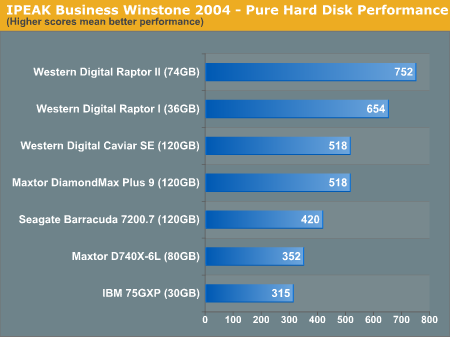
We see from the Business Winstone IPEAK scores that the two Raptor drives are, by far, the highest performers out of the bunch.
As our focus shifts down to the 7200RPM 8MB cache drives, we see that they all offer similar performance. In this case, the Western Digital WD1200JB and the Maxtor DiamondMax Plus 9 offer basically identical performance. The Seagate Barracuda 7200.7 falls behind somewhat, but what matters most is how these drives perform in the real world.
Looking at the older IBM 75GXP and Maxtor D740X drives, it's interesting to see that the fastest drives of today are around twice as fast as the fastest drives from a few years ago.
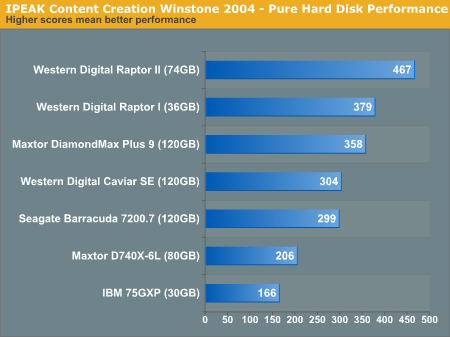
As we look at Multimedia Content Creation IPEAK performance, we see that the two Raptors continue to maintain a significant performance advantage over the competition. There is a bit of place switching as the Seagate 7200.7 and WD 1200JB perform much closer, with the Maxtor DiamondMax Plus 9 holding a bit of a lead.
Overall System Performance - Winstone
Historically, one of the most disk bound system performance tests has been the Winstone suite, composed of two benchmarks: Business Winstone 2004 and Multimedia Content Creation 2004.
Business Winstone 2004 tests the following applications in various usage scenarios:
- Microsoft Access 2002
- Microsoft Excel 2002
- Microsoft FrontPage 2002
- Microsoft Outlook 2002
- Microsoft PowerPoint 2002
- Microsoft Project 2002
- Microsoft Word 2002
- Norton AntiVirus Professional Edition 2003
- WinZip 8.1
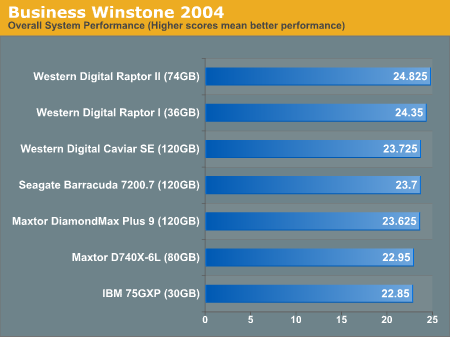
The first thing we see is that the new Raptor only offers a sub-2% performance advantage over the old drive. It is better than nothing, and there's no reason to opt for the old drive over the new one, but it's not a significant performance reason to upgrade.
The benchmarks also point out that if you are still running on an old 7200RPM 2MB cache drive, it is time to upgrade. The upgrade from an aging 75GXP to the latest generation Raptor will yield a perceptible 8% performance improvement, which is more than a lot of CPU upgrades will give you.
Multimedia Content Creation Winstone 2004 tests the following applications in various usage scenarios:
- Adobe® Photoshop® 7.0.1
- Adobe® Premiere® 6.50
- Macromedia® Director MX 9.0
- Macromedia® Dreamweaver MX 6.1
- Microsoft® Windows Media™ Encoder 9 Version 9.00.00.2980
- NewTek's LightWave® 3D 7.5b
- Steinberg™ WaveLab™ 4.0f
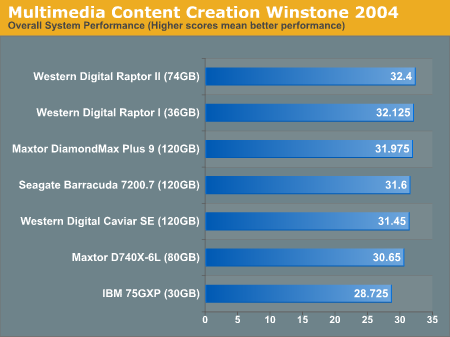
In MCC Winstone 2004, we see that the 2nd generation Raptor once again does not provide a significant real world performance boost over its predecessor, but still manages to turn out the fastest scores for this test.
The IBM 75GXP shows its age in this test, seeing how it manages to be no less than 11% slower than the fastest Raptor. Granted, it's a bad comparison to make, considering the Raptor is the latest and greatest while the 75GXP is years old, but it should serve as a compelling reason to upgrade for those of you still using the old 75GXP (assuming yours hasn't died yet).
Overall System Performance - SYSMark
SYSMark 2004 is divided into two separate suites: Internet Content Creation and Office Productivity. What makes SYSMark an ideal hard disk benchmark is that its scores are totals of response times, meaning that the benchmark measures how long the system takes to respond to a task (e.g. how long before a search and replace is completed after it is initiated) and sums up all such response times to generate a score. This score is generated for six total subcategories, three under Internet Content Creation and three under Office Productivity.
For the most part, SYSMark is CPU/platform bound, but we will see some variations in performance according to disk speed; at the same time, there are a couple of benchmarks within SYSMark that are heavily disk dependent.
First, we start with Internet Content Creation performance; the first category that we will deal with is 3D Content Creation. The tests that make up this benchmark are described below:
"The user renders a 3D model to a bitmap using 3ds max 5.1, while preparing web pages in Dreamweaver MX. Then the user renders a 3D animation in a vector graphics format."
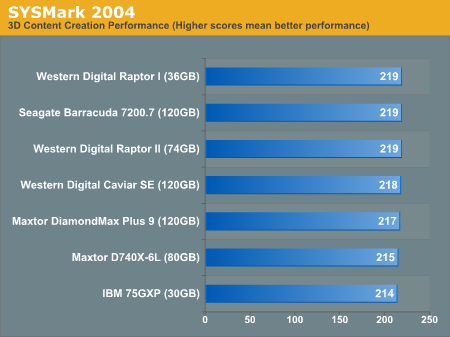
Generally speaking, 3D rendering is not a disk intensive task as your system is mostly CPU bound; we see proof of this in the SYSMark performance. While keeping in mind that SYSMark is more of a CPU test than a disk test, there's still very little variation between all of the drives in this test.
Next, we have 2D Content Creation performance:
"The user uses Premiere 6.5 to create a movie from several raw input movie cuts and sound cuts and starts exporting it. While waiting on this operation, the user imports the rendered image into Photoshop 7.01, modifies it and saves the results. Once the movie is assembled, the user edits it and creates special effects using After Effects 5.5."
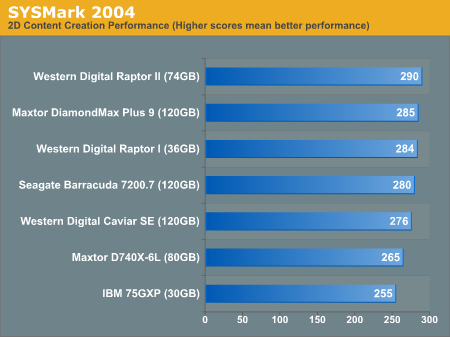
Here, we see that hard disk performance has a much bigger impact; the 2MB 7200RPM drives just don't cut it, with the current generation 8MB 7200RPM drives pulling close to a 10% advantage over the older drives. What is very important to note is that all three of the 8MB 7200RPM drives featured here perform about the same, lending support to the theory that current drives with similar specifications will perform similarly. Out of the bunch, the Maxtor DiamondMax Plus 9 manages to hold a small lead, with the new Raptor enjoying a slight lead over even that drive.
The Internet Content Creation suite is rounded up with a Web Publishing performance test:
"The user extracts content from an archive using WinZip 8.1. Meanwhile, he uses Flash MX to open the exported 3D vector graphics file. He modifies it by including other pictures and optimizes it for faster animation. The final movie with the special effects is then compressed using Windows Media Encoder 9 series in a format that can be broadcast over broadband Internet. The web site is given the final touches in Dreamweaver MX and the system is scanned by VirusScan 7.0."
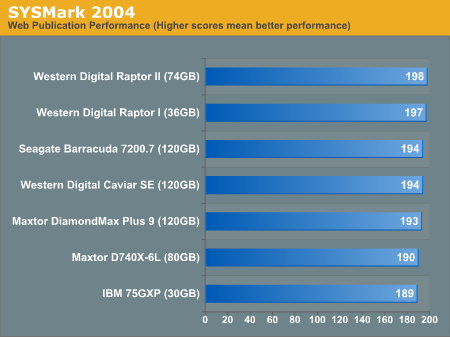
Here, we see that performance is quite similar between all of the contenders, with the Raptors taking the slight lead and the remaining 8MB cache drives all offering similar performance.
Overall System Performance - SYSMark (continued)
SYSMark's Office Productivity suite consists of three tests, the first of which is the Communication test. The Communication test consists of the following:
"The user receives an email in Outlook 2002 that contains a collection of documents in a zip file. The user reviews his email and updates his calendar while VirusScan 7.0 scans the system. The corporate web site is viewed in Internet Explorer 6.0. Finally, Internet Explorer is used to look at samples of the web pages and documents created during the scenario."
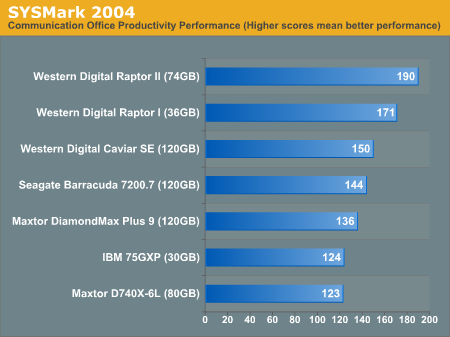
The Communication test tends to be very disk dependent and thus, we see significant differences between the drives. The advantage of a larger cache is evident, as the newer 7200RPM drives hold at least a 10% performance advantage over the older drives.
This test also shows a significant performance advantage for the Raptors. This is the first test in our suite that shows a substantial difference between the first and second generation Raptors, with the new Raptor outpacing the old one by 11%. The new Raptor also manages to offer a 27% performance advantage over the fastest 7200RPM drive in this comparison. What is very important about this advantage is that it is a 27% advantage, not in a disk only test, but in a real world test. Any situation where a drive is able to increase overall system performance by 27% is one that demands attention, especially if it isn't an unusual situation; in this case, it very much isn't.
The next test is Document Creation performance, which shows very little difference in drive performance between the contenders:
"The user edits the document using Word 2002. He transcribes an audio file into a document using Dragon NaturallySpeaking 6. Once the document has all the necessary pieces in place, the user changes it into a portable format for easy and secure distribution using Acrobat 5.0.5. The user creates a marketing presentation in PowerPoint 2002 and adds elements to a slide show template."
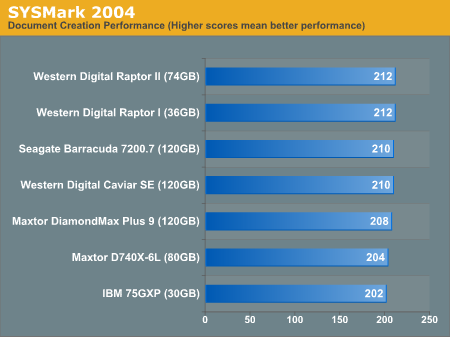
The biggest difference here is less than 5%, so there's not too much to talk about. The drives' impact on performance is basically negligible.
The final test in our Office Productivity suite is Data Analysis, which BAPCo describes as:
"The user opens a database using Access 2002 and runs some queries. A collection of documents are archived using WinZip 8.1. The queries' results are imported into a spreadsheet using Excel 2002 and are used to generate graphical charts."
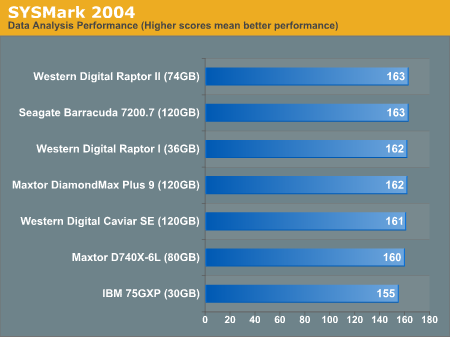
Although you would think that Data Analysis would show significant differences in drive performance, this particular test still isn't as disk bound as the Communication test. The performance spread here is 5%.
SYSMark Performance Summary
The overall SYSMark scores summarize what we've seen thus far:
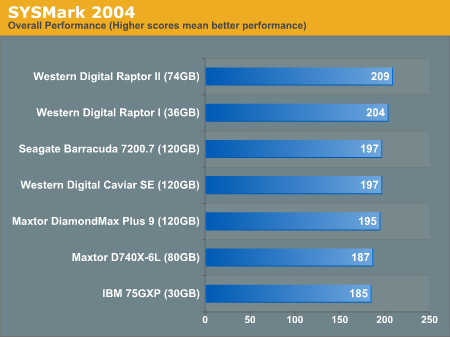
As a recap, here's what happens with the Internet Content Creation suite:
"In this scenario, the content creator creates a product-related website targeting a broadband and narrowband audience. The user first renders a 3D model to a bitmap, while preparing web pages using a web site publishing tool. The user opens a video editing package, creates a movie from several raw input movie cuts and sound cuts and starts exporting it. While waiting on this operation, the user imports the rendered image into an image-processing package, modifies it and saves the results. Back in the 3D modeling software, the user modifies a 3D model and exports it to a vector-graphics format. Once the movie is assembled, the user edits it and creates special effects using one of the modified images as input. The user extracts content from an archive. Meanwhile, he uses an animation creation tool to open the exported 3D vector graphics file. He modifies it by including other pictures and optimizes it for faster animation. The final movie with the special effects is then compressed in a format that can be broadcast over broadband Internet. The web site is given the final touches and the system is scanned for viruses."
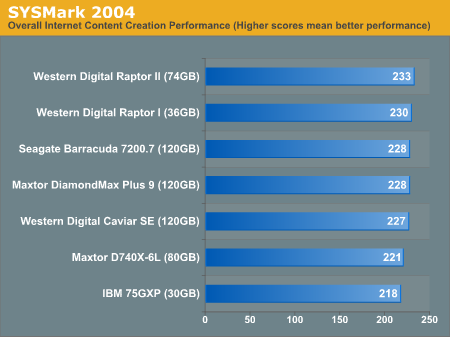
In the Internet Content Creation tests, we see that although there is a difference in performance between current and previous generation hard drives, there's very little that separates the 10,000RPM Raptors from the 7200RPM drives.
Also recapping, here's what happens in the entire Office Productivity suite:
"In this scenario, the office productivity user creates a marketing presentation and supporting documents for a new product. The user receives email containing a collection of documents in a compressed file. The user reviews his email and updates his calendar while a virus checking software scans the system. The corporate web site is viewed and the user begins creating the collateral documents. The user also accesses a database and runs some queries. A collection of documents are compressed. The queries' results are imported into a spreadsheet and used to generate graphical charts. The user then transcribes a document. Once the document has all the necessary pieces in place, the user changes it into a portable format for easy and secure distribution. The user edits and adds elements to a slide show template. Finally, the user looks at the results of his work (both the slide show and the portable document) in an Internet browser. "
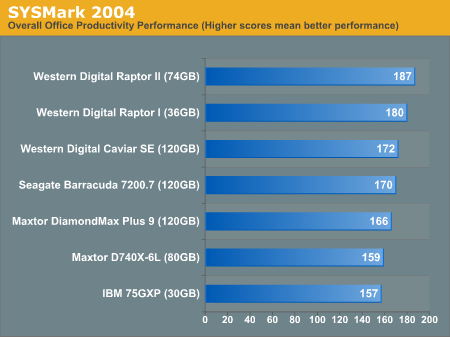
Office Productivity paints a much different picture, with significant advantages being seen over older drives. The Office Productivity suite also paints a much more compelling picture of the Raptors' performance; even the older Raptor manages to maintain a decent performance advantage over the cream of the crop 7200RPM 8MB Parallel ATA drives.
Overall performance is an average of the two suites, and thus, we see that a lot of the impressive performance gains in Office Productivity are diluted by the relatively little variation in Internet Content Creation performance.
Game Loading Performance
One test that everyone wants to see when it comes to hard disk reviews is something game-related. For the most part, gamers agree that your hard drive isn't limiting performance while you're actually playing a game. After all, if you are swapping to disk a lot, then your gaming experience is going to be pretty poor, regardless of how fast your disk is. But what is important and very noticeable when it comes to disk performance in games are loading times.
Today's games have arguably some of the worst loading times ever, thanks to extremely large artwork, levels and other game data that must be loaded before game play can begin. Games also provide a very tangible and perceivable platform for hard disk performance comparison; while even Winstone scores may be difficult to relate to, everyone knows what waiting longer feels like.
For our game loading tests, we used two games: Far Cry and Unreal Tournament 2004. Both games were installed, in full, to the hard drive. We then used no-CD patches to prevent any accessing of the CD/DVD drive to skew the loading process. Both games were installed to a clean drive without anything else present on the drive (the OS is located on a separate drive).
Our Far Cry test consists of starting a campaign with the default difficulty level, hitting escape to skip the introductory movie and beginning the stop watch timer at first sight of the loading screen. The stop watch timer is stopped as soon as the loading screen disappears. The test is repeated three times with the final score reported being an average of the three. In order to avoid the effects of caching, we reboot between runs. All times are reported in seconds, lower scores obviously being better.
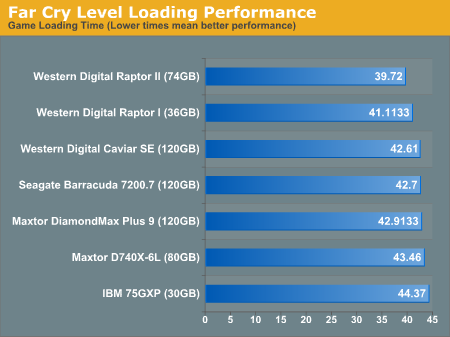
The benefits of a 10,000RPM spindle speed are not much when just looking at the first generation Raptor, but the new Raptor manages to offer a 6% performance advantage even over the current generation 7200RPM 8MB cache drives.
Our Unreal Tournament 2004 test uses the full version of the game and leaves all settings on defaults. After launching the game, we select Instant Action from the menu, choose Assault mode and select the Robot Factory level. The stop watch timer is started right after the Play button is clicked, and stopped when the loading screen disappears. The test is repeated three times with the final score reported being an average of the three. In order to avoid the effects of caching, we reboot between runs. All times are reported in seconds, lower scores obviously being better.
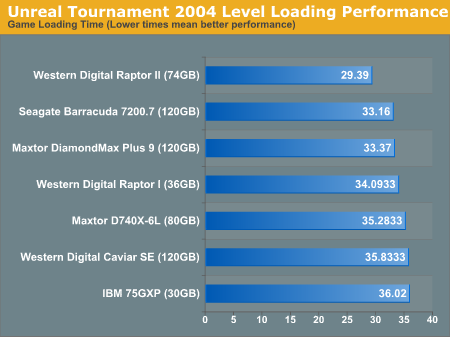
The UT test shows similar standings (although there is a bit of swapping amongst the 7200RPM 8MB cache contenders), but the 2nd generation Raptor extends its lead over its predecessor significantly. The first generation Raptor is even slightly outpaced by Seagate's 7200.7 series.
Noise Comparison
We're still hammering out exactly how we want to do sound comparisons of drives, but one thing we definitely want to include are sample sound files of the drives themselves.
The drives were tested outside of a case, with no fans in the case running. The microphone was placed 1.5" away from the front right side of the drive (connectors at the back, PCB exposed on top). The clicking at the beginning and end of the recording are sounds not related to the drive, but fumbling with the power switch on the case. The sounds that you are hearing are the drive spinning up and initializing itself.
All files are provided in MP3 format and are recorded in a 32kbps mono format.
IBM 75GXP - MP3
Maxtor D740X-6L - MP3
Maxtor DiamondMax Plus 9 - MP3
Seagate Barracuda 7200.7 - MP3
Western Digital Caviar SE - MP3
Western Digital Raptor I - MP3
Western Digital Raptor II - MP3
What's important to note here are how quiet the new Raptor and newer 7200 RPM drives are. The Western Digital included in the review does not use fluid bearings and is much older than the other two 7200RPM drives, which helps explain why it is so loud. The most impressive of the 7200RPM drives is definitely the Seagate 7200.7; it's virtually silent when idle. The Maxtor DiamondMax Plus 9 is also an impressive offering.
Final Words
The importance of this review, the reviews to come and our new HDD test suite in general is that we are finally able to bring real world hard drive performance numbers to you all. So, what do our real world performance tests show us?
They show us that, for the most part, all of the current generation 7200RPM 8MB cache drives perform about the same. Although there are much more significant differences between the three current-gen contenders here in the synthetic tests, in the real world, we see that they all perform just about the same.
Our tests have also shown us that the 10,000RPM Raptor can offer a noticeable, but not dramatic, performance improvement over the current generation 7200RPM 8MB cache drives. While the performance improvement is there, it's not as significant as the synthetic tests would have you believe.
More importantly than all of this is the fact that our tests have shown the true age of older 2MB cache drives. The 75GXP, once the most popular drive around, is definitely showing its age and the performance of the even newer Maxtor D740X-6L isn't that far off. If you're still running an older drive, you will see a performance improvement by going to even one of the current generation 7200RPM 8MB cache drives. It is all too often that we look at hard drives as capacities alone, but while a 80GB drive may be suiting your needs just fine an upgrade to a newer 120+ GB drive will give you more space and a performance boost to match. The thing to keep in mind is that the more up-to-date you keep your hard drive performance, the faster your system will feel and the more performance you'll get out of every upgrade of your CPU, motherboard, chipset, etc.
With our new test suite, we are committed to bringing you reviews of any drive that's available. All we ask is that you give us feedback. If you'd like to see a drive reviewed, let us know and we'll do our best to get it reviewed under the new test suite. We're going to be focusing on IDE/SATA drives first, but we will definitely move to include SCSI drives as well as controllers in the very near future. All you need to do is drop us a line and tell us what you'd like to see.







